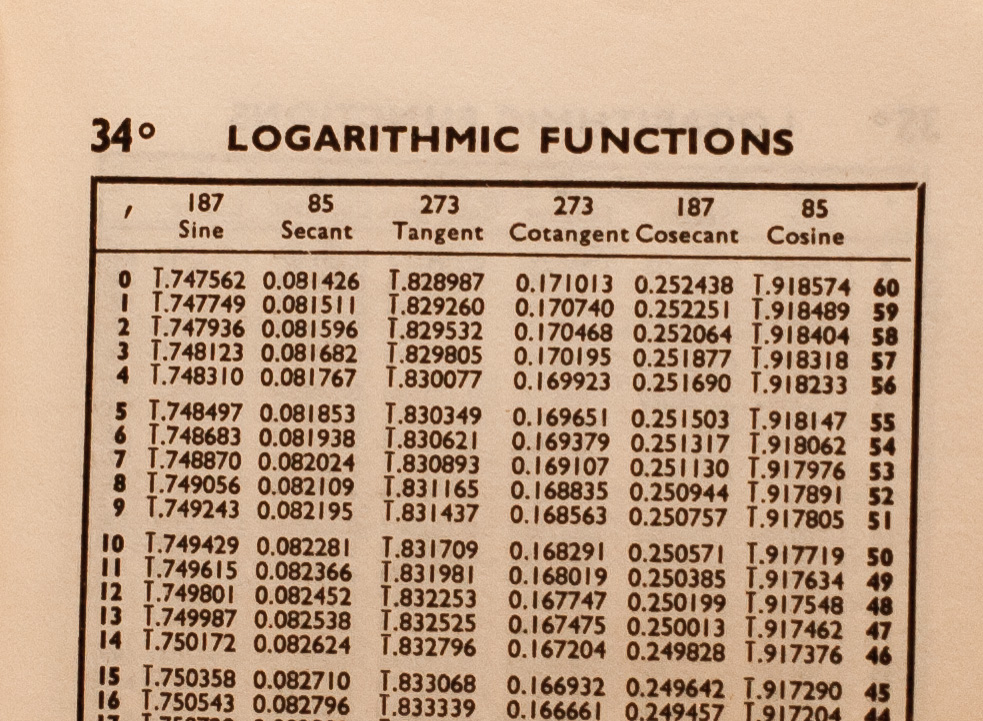
The table could be used to do divisions and find square roots, although its actual uses are unknown.
#LOGARITHM TABLES BOOK SERIES#
Numbers that are not directly represented, would have to be converted into a series of additions.

The table can also help users to multiply any whole or half integer between 0.5 and 99.5. The entries at the intersection of each row and column in the matrix provide the results of multiplying the corresponding numbers. The top row and the rightmost column contain, arranged from right to left and from top to bottom respectively: the number 0.5 the integers from 1 to 9 and multiples of 10 from 10 to 90 (Qiu 2014). The bamboo slips are 7 to 12 millimetres wide and up to half a metre long slips. They correspond to the period of the Warring States (circa 305 BC). The bunch included 21 slips (Figure 4), giving one of the probably oldest known recording of the decimal multiplication table ( Suanbiao). These are now in the Tsinghua University Arts Museum. A few years ago, a 2300 year old bunch of bamboo slips were discovered, possibly in the excavation of a tomb (Qiu 2014). The leather scroll contains sums of unit fractions. The Lahun papyrus IV.2 fragment reports a 2/ n table for odd n, n = 1, , 21. Ahmes notes that his scroll is a copy of older scrolls. It was created by the scribe Ahmose (or Ahmes) who wrote down eighty-four problems including a 2/n table as well as a second smaller table of fractional expressions for the numbers 1 through 9 divided by 10. Most of the papyrus is in the British Museum London and is named after Alexander Henry Rhind a British antiquarian. The close to 5 meter long, Rhind (Ahmes) Papyrus was discovered near Luxor, Egypt. These tables or parts thereof are found on the Rhind and Lahun papyrus and the leather scroll.
#LOGARITHM TABLES BOOK FULL#
The Egyptian way of calculating involved multiplication or division by two and additions, so that they did not require a full multiplication table of the type used now. The papyri generally list some problems pertaining to geometry with calculations of areas and volumes and include tables of divisions, multiplication and handling of fractions. The other two, the Lahun (or Kahun Petrie Museum of Egyptian Archeology, University College London.) and Berlin 6619 (Staatliche Museen Berlin) are very fragmented. The two main papyri, with large intact portions, are the so called Moscow or Golenishchev (Pushkin Museum of Fine Arts, Moscow E4676) and Rhind ( British Museum, EA10058) papyri, dating from circa 1850 BC and 1550 BC. These date to the time of the Middle Kingdom (2055-1650 BC ).

2538), a leather roll (British Museum BM10250, etc). The Egyptian fractional tables. The main source of information regarding Egyptian mathematics comes from four surviving papyri (e.g. Imhausen 2016) and a few other objects ( Akhmim wooden tablets, also known as the Cairo wooden tablets (Museum of Egyptian Antiquities, Cat. The interested reader can find a detailed description of ancient mathematics in e.g. We look here briefly at some ancient tables. So who invented the multiplication table? Many people.

At the end, some later variants of Napier’s rods are shown, including contributions of Wilhelm Schikard, Athanasius Kircher, Gaspard Schott, René Grillet, Samuel Morland, Pierre Petit, Jacob Leupold, Genaille-Lucas and a few others.Īs some may remember, many old school notebooks, would systematically have a multiplication table on a cover page. In this page we have a quick look at these developments, starting with arithmetical/mutiplication tables and lattice multiplication and then at John Napier ‘s famous logarithms and his calculation aids: the so called Napier bones, Multiplication Promptuary. Many years ago, in a world where few people studied, much effort was devoted to create simple devices that could aid in performing all kinds of tedious, yet essential, arithmetic calculation.

We might still try to do this manually, but what about extracting a square root? Since the 70’s using an electronic calculator is so much easier, but children still need to learn the multiplication table: one of the first tables designed to help in calculations. Today, most of us rarely do simple calculations by hand, but grab a pocket calculator (or a smartphone) and do all our additions subtractions and multiplications with it.


 0 kommentar(er)
0 kommentar(er)
